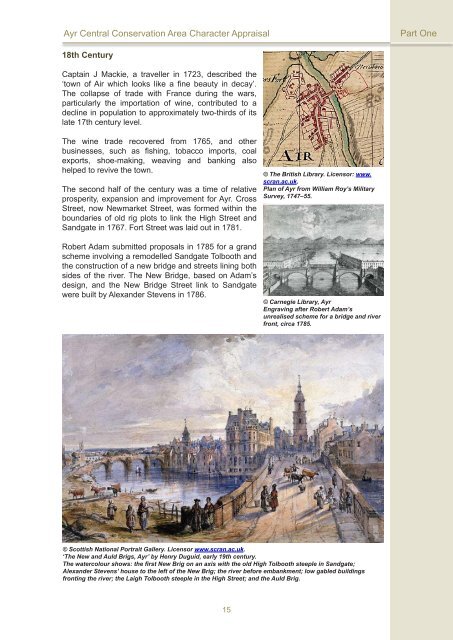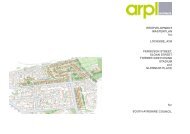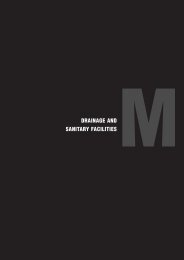Ayr Central Conservation Area Character Appraisal - South Ayrshire ...
Ayr Central Conservation Area Character Appraisal - South Ayrshire ...
Ayr Central Conservation Area Character Appraisal - South Ayrshire ...
Create successful ePaper yourself
Turn your PDF publications into a flip-book with our unique Google optimized e-Paper software.
<strong>Ayr</strong> <strong>Central</strong> <strong>Conservation</strong> <strong>Area</strong> <strong>Character</strong> <strong>Appraisal</strong><br />
Part One<br />
18th Century<br />
Captain J Mackie, a traveller in 1723, described the<br />
‘town of Air which looks like a fine beauty in decay’.<br />
The collapse of trade with France during the wars,<br />
particularly the importation of wine, contributed to a<br />
decline in population to approximately two-thirds of its<br />
late 17th century level.<br />
The wine trade recovered from 1765, and other<br />
businesses, such as fishing, tobacco imports, coal<br />
exports, shoe-making, weaving and banking also<br />
helped to revive the town.<br />
The second half of the century was a time of relative<br />
prosperity, expansion and improvement for <strong>Ayr</strong>. Cross<br />
Street, now Newmarket Street, was formed within the<br />
boundaries of old rig plots to link the High Street and<br />
Sandgate in 1767. Fort Street was laid out in 1781.<br />
Robert Adam submitted proposals in 1785 for a grand<br />
scheme involving a remodelled Sandgate Tolbooth and<br />
the construction of a new bridge and streets lining both<br />
sides of the river. The New Bridge, based on Adam’s<br />
design, and the New Bridge Street link to Sandgate<br />
were built by Alexander Stevens in 1786.<br />
© The British Library. Licensor: www.<br />
scran.ac.uk.<br />
Plan of <strong>Ayr</strong> from William Roy’s Military<br />
Survey, 1747–55.<br />
© Carnegie Library, <strong>Ayr</strong><br />
Engraving after Robert Adam’s<br />
unrealised scheme for a bridge and river<br />
front, circa 1785.<br />
© Scottish National Portrait Gallery. Licensor www.scran.ac.uk.<br />
‘The New and Auld Brigs, <strong>Ayr</strong>’ by Henry Duguid, early 19th century.<br />
The watercolour shows: the first New Brig on an axis with the old High Tolbooth steeple in Sandgate;<br />
Alexander Stevens’ house to the left of the New Brig; the river before embankment; low gabled buildings<br />
fronting the river; the Laigh Tolbooth steeple in the High Street; and the Auld Brig.<br />
15

















